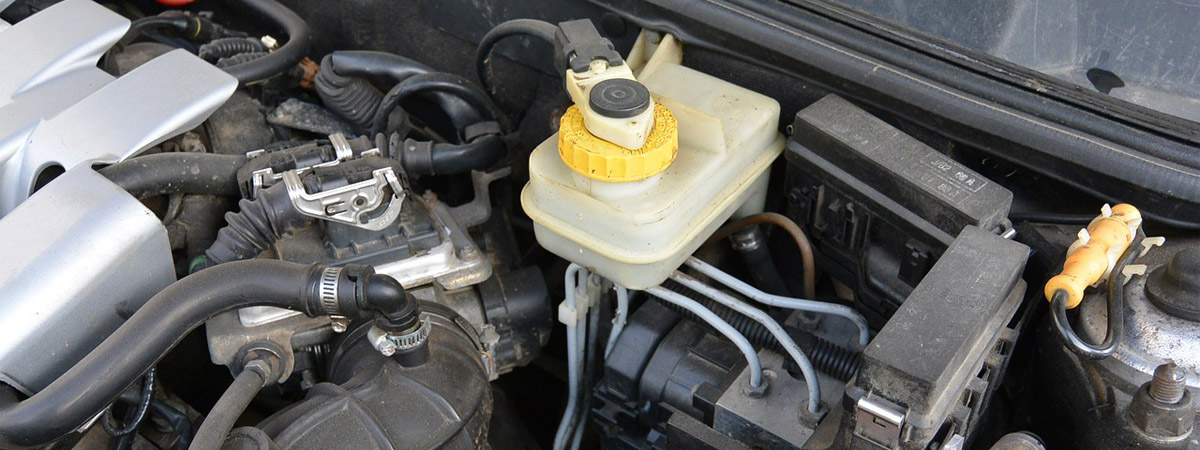Brake fluid: why refreshing and choosing the correct type are so important for the ABS system
Every car enthusiast has a bottle of it in the shed: brake fluid. The liquid, which is almost always based on glycol ether, is purchased in large numbers by garage owners. And we’re thankful of that! Brake fluid can have a big effect on the braking system and the ABS system. Read more about it below!
Different types of brake fluid
As mentioned, almost all brake fluids are based on glycol ether. Nevertheless, various fluids with a mineral or silicone base have been marketed in the past. For example, Citroën introduced the LHM (Liquide Hydraulique Minéral) brake fluid in 1966. Unfortunately, it later turned out that this fluid caused internal corrosion in the braking system. Silicone brake fluid was therefore introduced as part of the DOT standard. The DOT name is derived from the name of the US Federal Department of Transportation, which is known as the Department of Transportation.

The advantages and disadvantages of glycol ether and silicone brake fluid
This so-called DOT 5 brake fluid (silicone-based) had the great advantage over the older DOT 4 (mineral-based), because it had a much higher boiling point. The dry boiling point went from 230 ° C to 260 ° C and the wet boiling point from 155 ° C to 180 ° C. However, this DOT 5 brake fluid had a number of important drawbacks. A silicone-based brake fluid is not compatible for cars that use an ABS system. Since all European cars have been required to utilize an ABS system since 2004, silicone was not the new next big thing. Nowadays this type of brake fluid is actually only used in motorsport. Another important disadvantage of a silicone-based brake fluid is that it is more "compressible". This makes the brake pedal feel spongier.
Anyway, why would you develop silicone brake fluid at all? What's wrong with the trusty glycol ether brake fluid? The answer lies in the chemical properties of this fluid. Glycol-ether brake fluid such as DOT 4 and the even older DOT 3 are hygroscopic, while a silicone brake fluid such as DOT 5 is hydrophobic. This means that glycol ether brake fluid attracts moisture which then mixes with the fluid. Slowly but surely, the brake fluid becomes cloudy and an increasing proportion of it consists of water. That also causes corrosion in the system. And since water at 100 ° C has a much lower boiling point than brake fluid, there is also the possibility that the brakes will boil.
DOT 5.1 and changing brake fluid
So back to the drawing board. Because how do you get the benefits of a higher boiling point in a glycol ether brake fluid? The solution came under the name DOT 5.1 brake fluid. In contrast to DOT 5, this brake fluid can be used in combination with ABS systems. And speaking of that ABS system: DOT 5.1 brake fluid has the important advantage that it maintains a constant and low viscosity over a wide range of temperatures. This constant viscosity is very important for the operation of, for example, the ABS and ESP systems. This means that the valves in the system can respond quickly when needed. In addition, the DOT 5.1 brake fluid, just like the DOT 5 brake fluid, has a much higher boiling point than DOT 4. This brake fluid is therefore more durable. For this DOT 3 and DOT 4 brake fluid it is very important to change it at least once every two years, while with DOT 5.1 brake fluid you can generally continue driving a little longer.
But, be careful! Also DOT 5.1 brake fluid becomes cloudy over time and can therefore seriously affect the entire braking system. The ABS system is also an important part of this. Every day we see ABS units arriving our remanufacturing department that have completely jammed due to clouded brake fluid. This means that the hydraulic and electronic components can no longer respond if an abrupt braking action is performed. That is why the ABS units are always flushed in our remanufacturing process so that all remaining brake fluid is removed from the component. That way, we can guarantee that the ABS-unit gets a fresh and new start!

 da
da de
de es
es fr
fr it
it nb
nb nl
nl pt
pt sv
sv fi
fi